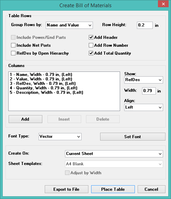
The schematic is complete, but there are parts that are only generically identified: 1K resistor, 47K resistor, 10uF cap, 0.1uF cap, 0.01uF cap, 32KHz crystal, and LED. These generic parts need to be nailed down to the specific parts that I will be using. This is also where I start to build the Excel spreadsheet that will serve as the BOM (Bill of Materials) for the project.
It may be tempting to skip creating the Bill of Materials for a small project, but it is the central document that ties the project together. This is will become the definitive reference used to build the board. Taking time and being diligent and specific to the point of neurosis to create a complete and accurate BOM will pay dividends over the lifetime of the project. Do not skimp on the BOM.
DipTrace can create a BOM very easily. In the Schematic Capture create a new sheet (Edit > Add Sheet) and name it "BOM". Click "Objects > Bill of Materials..." to bring up the BOM edit window.
Order the BOM by "Parts" to create a table row for each part in the design. This will make transferring the data to the Excel spreadsheet easier. Add columns for RefDes, Name, Value, and Description. Click "Place Table" and click anywhere on the sheet to place it. The BOM does not update once it is placed! Whenever the schematic changes, I need to remember to manually delete and recreate the BOM.
I then use the DipTrace BOM to create an external Excel spreadsheet which I will use to manage the procurement process.
My BlinkBOM.xlsx has two sheets, the first sheet lists each part specified in the schematic. Multiple parts (RefDes) can refer to the same component (PartRef). PartRef is an index into the Parts sheet, which lists all the unique parts, and the information on how to order the parts and where to find the datasheets.
This cross-referencing is accomplished by a couple formulae:
The Parts sheet has a row for each unique component in the design with the following columns:
These are all cheap commodity parts and normally it would be quicker, easier, and less error-prone to simply pick the parts out of the Digikey catalog, order them, and extract the patterns from the datasheets. However, I know I have all these parts in stock at the office and it is just a matter of determining the precise part number so I can look up the datasheets to create the pad patterns.
Once again, the hardest part about creating the patterns is finding the information. All components must have a specific matching pattern before I can generate any board layouts.
I found the standard Cap0603 and Res0402 patterns in the stock DipTrace libraries. Right-click the component in the schematic, Replace Part. Then Add Library, navigate to the DipTrace installation folder, Libraries, __discrete_smd.lib.
My BOM now tells me I am now missing the patterns for only the crystal and the LED. I grabbed the LED from the Digikey site using the VendorID. I also added a second red led. This is the point in the project where I need to be very conscious of feature creep. It is very easy to add features, and there is an infinite supply of them. But the purpose of this project is to build the World's Simplest MSP430 board. Extra features are the enemy!
Now the only missing pattern is the crystal. I don't have the part number for the crystal so I need to go to the office to read it from the package. Hmmm... This is a very frustrating experience, sifting through bins of old projects looking for a 32KHz crystal. I know it was used in some previous project, but I could not find any. This reinforced two things:
So I need to select a 32KHz crystal from Digikey. I start by entering "32KHz crystal" in the search box, then click "Crystals". Narrow my search, one term at a time:
Wow, only two SMD item! Abracon Corporation at $1.089 each for 10, and Citizen Finetech Miyota at $1.625 each for 10. Both have the same footprint, and having no preference I go for the cheaper Abracon. Digikey 535-10242-6-ND.
UPDATE: DigiReel was not the correct choice, I should have ordered them as cut tape. Any quantity less than 1000 is easier to manage using strips of tape laid out on the PnP tray. Reels are for large quantities, in the thousands.